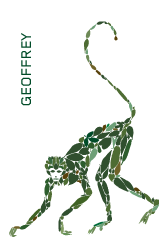March’s Tree of the Month is the balsa (Ochroma pyramidale), a pioneer species best known for its fast growth and lightweight wood.
Native to the Americas, the balsa is found throughout the region, ranging from Southern Brazil to Mexico. Today, the balsa is also found in several other tropical and sub-tropical regions of the world. The balsa is a member of the Malvaceae family, which also includes the panamá (Sterculia apetala), the cuipo (Cavinillesia platanifolia), and the ceiba (Ceiba pentandra).
The balsa is known for growing very quickly—the trees can reach heights of 30 meters in as little as 10-15 years. Because the tree grows so quickly, balsa wood is extremely lightweight, and is less dense even than cork. But despite its apparent lightness, balsa wood is relatively strong, and is considered a commercial hardwood.
Being highly buoyant (the density of balsa wood is one-fifth of the density of water), balsa wood is commonly used in the construction of boat decks and hulls. It is also frequently used in laminates, combined with other reinforced materials to build things like wind turbines, car floorboards, and ping-pong paddles. Balsa wood is popular for model building, and is often used to make popsicle sticks and other basic disposable goods. Today, 95% of commercial balsa wood is grown in Ecuador, much of it in dense plantations.
In Panama, the balsa tree generally flowers at the beginning of the dry season. The large yellow-white flowers of the balsa open during the night, revealing pools of nectar that can be more than an inch deep. A wide variety of animals feed on the nectar of the balsa flower, spreading pollen from tree to tree in the process. Bats, known to be nocturnal nectarivores, were once thought to be the principal pollinators of the balsa. But in recent years researchers have come to realize that bats may play a small role in comparison to more prolific nectar guzzlers that visit balsa trees throughout the tropics, such as capuchin monkeys, kinkajous, and olingos. For more on the flowering of the Ochroma and photos of the many pollinators invited to the feast, see this feature article from National Geographic.
The fruit of the Ochroma tree is a curved, striated pod up to 15 cm in length. The pod splits open to reveal a fluffy cotton-like material that surrounds several small seeds. Balsa seeds are primarily dispersed by wind. The pale, downy fibers catch the breeze and bear the seeds away to new locales.
With its large, palmately lobed leaves and its rapid growth, the balsa is an effective pioneer, often one of the first species to colonize treeless spaces. Its broad leaves provide shade for slower-growing species that eventually rise to dominance in mature sections of the forest. These late-successional species gradually overtake quick starters like the Ochromae, which tend to live only 30 or 40 years, a relatively short time in the world of trees.
Get out and see the balsa while its still in bloom!








